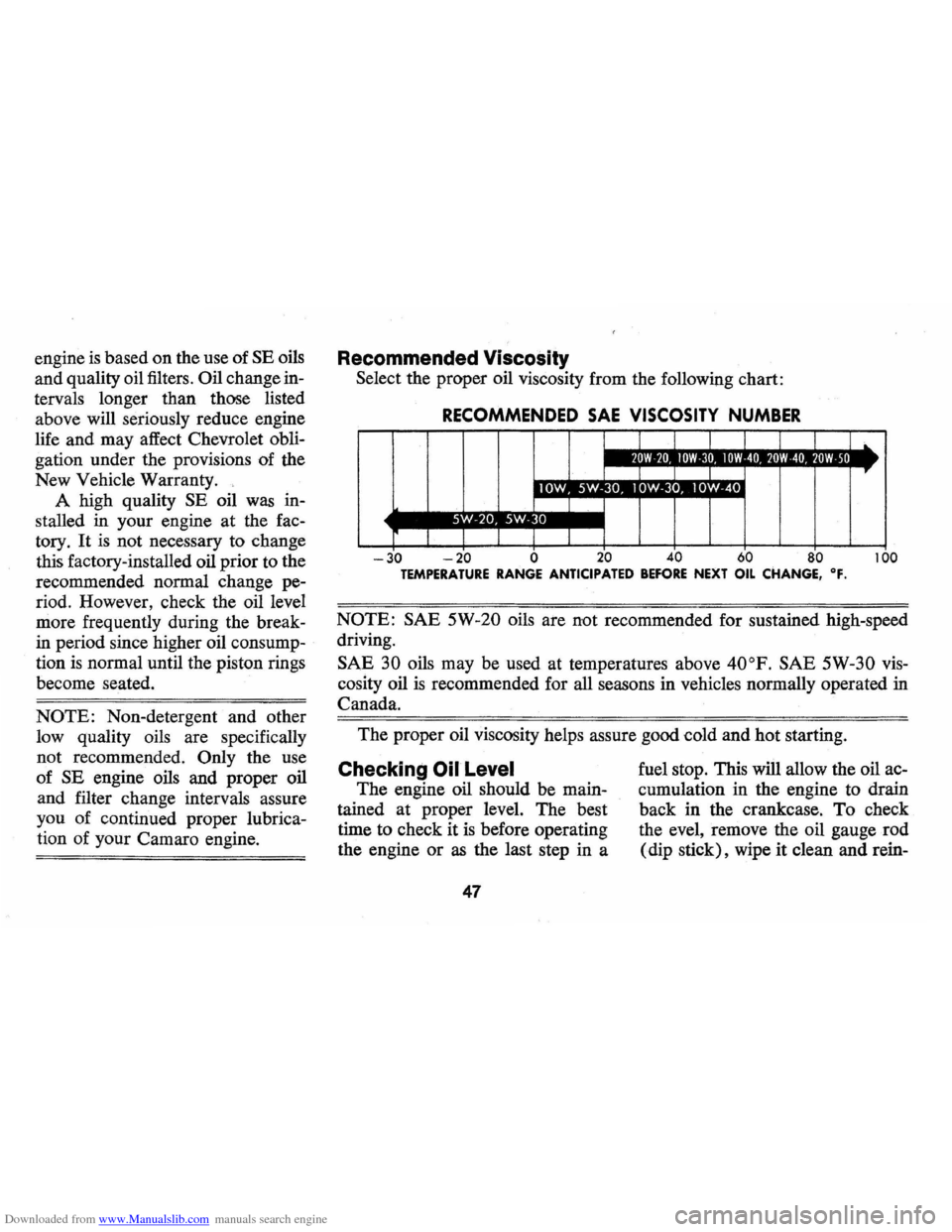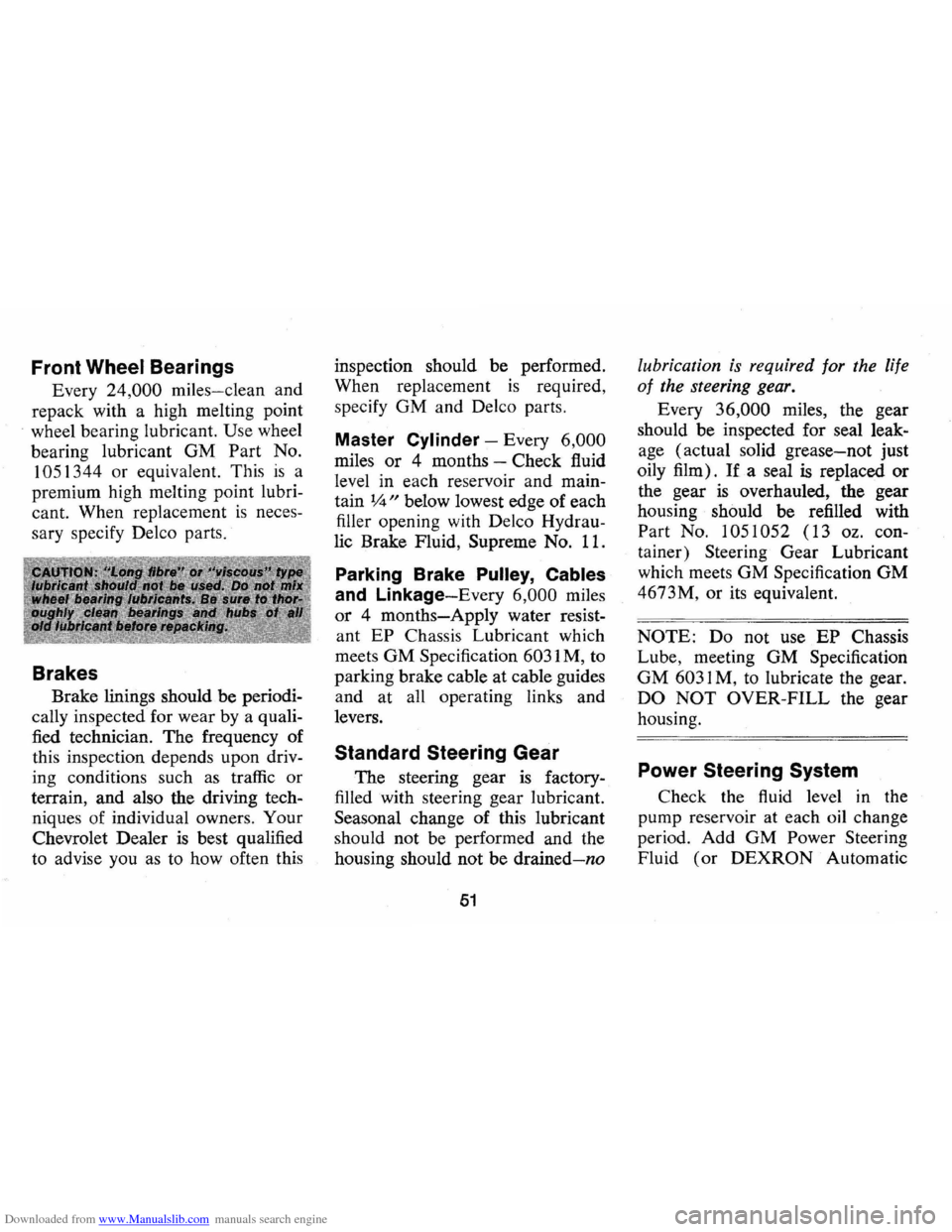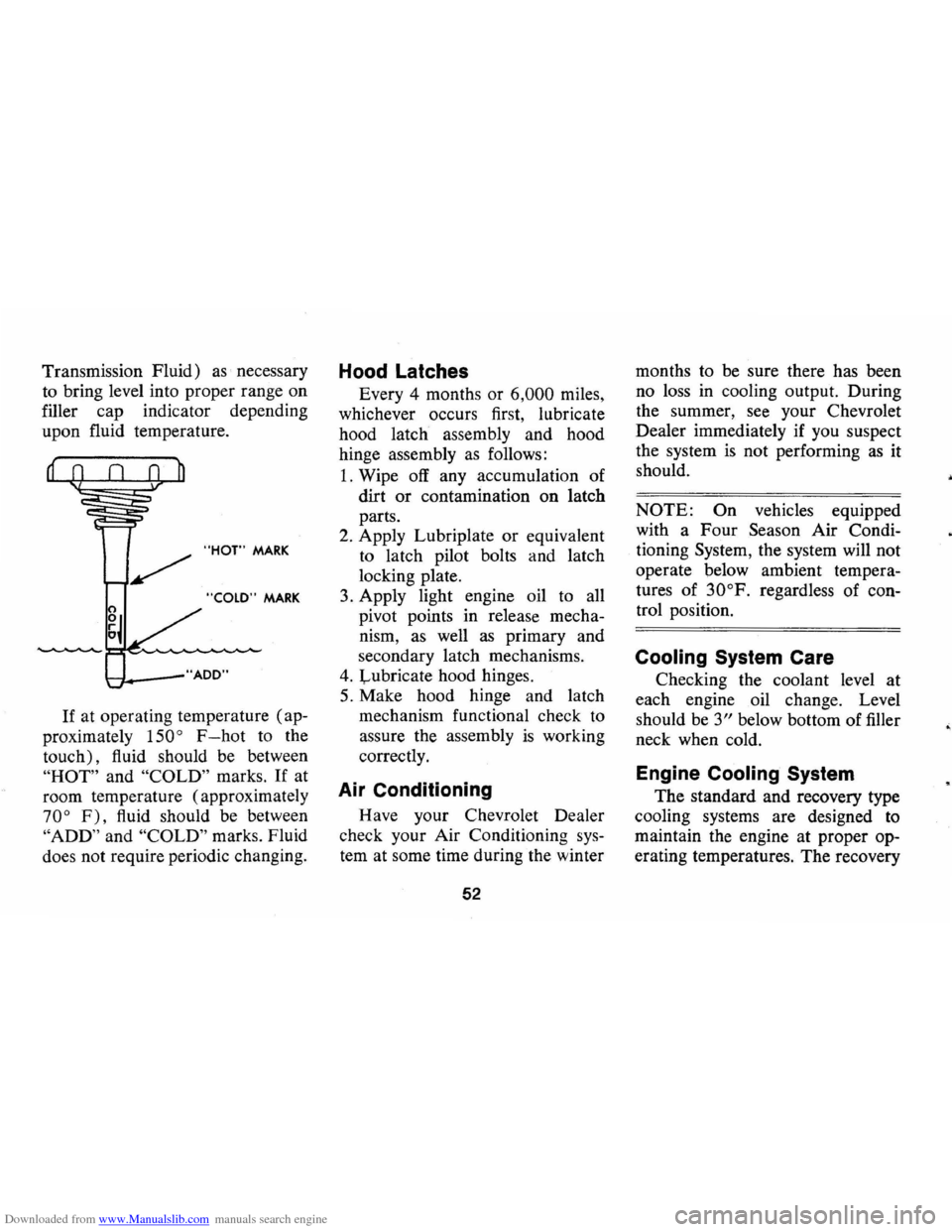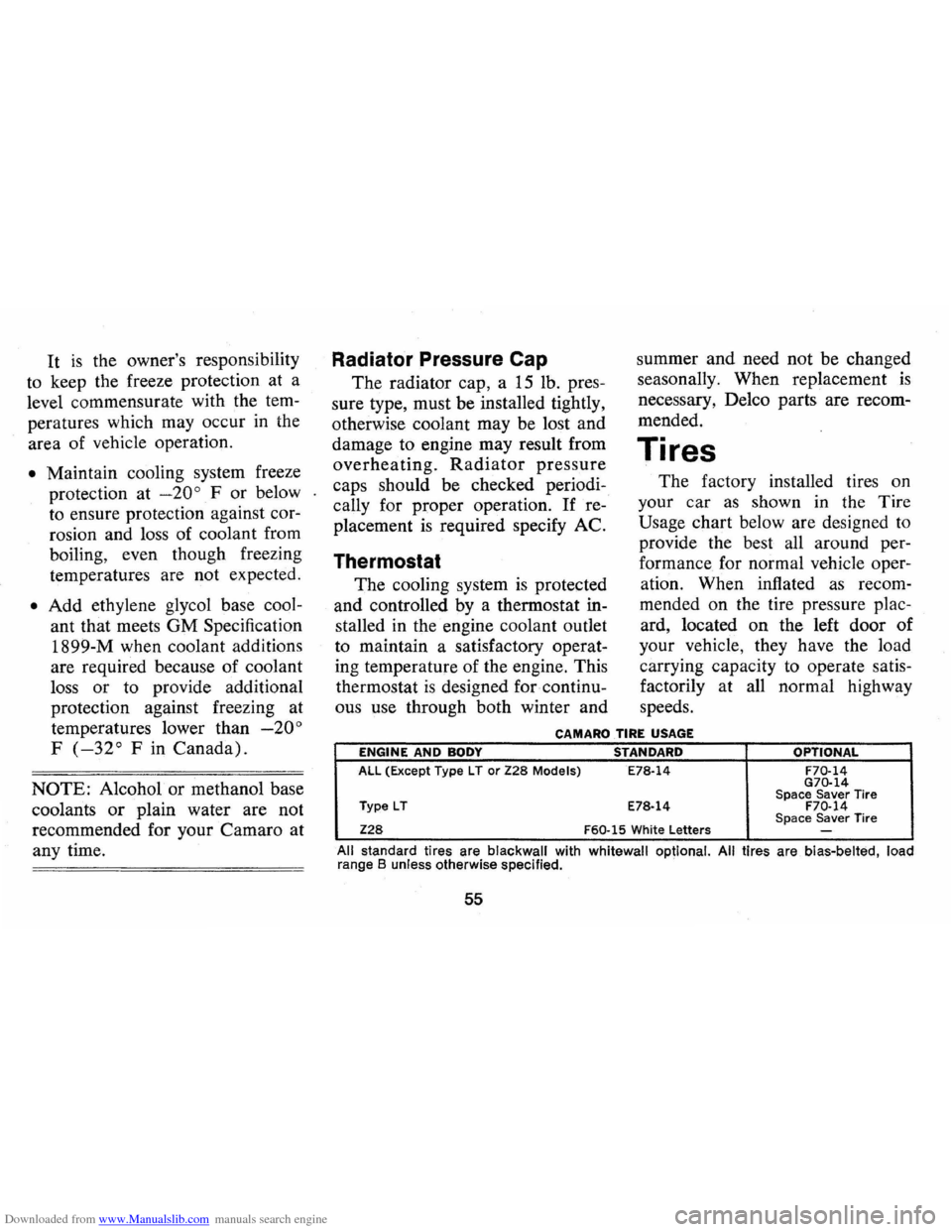1973 CHEVROLET CAMARO oil change
[x] Cancel search: oil changePage 13 of 84

Downloaded from www.Manualslib.com manuals search engine properly when riding. However,
if unusual conditions prohibit
use of restraints and require
Trailer Hauling
Since passenger cars are designed
and intended to be used primarily
as passenger conveyances, towing
a trailer will affect handling, dura
bility and economy. Maximum
safety and satisfaction depends
upon proper use of correct equip
ment and· avoiding overloads and
other abusive operation.
The maximum loaded trailer
weight which you can pull with your
Camaro depends on what special
equipment has been installed on
your car. Chevrolet does not rec
ommend towing any trailer unless
the car
is properly equipped. Infor
mation
ori trailer hauling capabili
ties, special equipment required,
and optional equipment offered
by
Chevrolet is available from your that
a child must stand,
he
should stand on the floor direct
ly behind the front seat. This will
Chevrolet Dealer or by wntmg:
Chevrolet Motor Division, Detroit,
Michigan 48202
(or in Canada
by writing to General Motors of
Canada Limited,
Owner Relations
Department,
Oshawa, Ontario).
To assist
in attaining good han
dling of the car-trailer combina
tion, it
is important that the trailer
tongue load be maintained at ap
proximately 10% of the loaded
trailer weight. Tongue loads can
be
adjusted by proper distribution of
the load in the trailer, and can
be
checked by weighing separately
the loaded trailer and then the
tongue.
When towing trailers, tires should
be inflated to the highest infla
tion pressures shown on the placard
10
help minimize the possibility of
injury from frontal impacts in
the event of an accident.
affixed to the left front door. The
allowable passenger and cargo
load, also shown on the same plac
ard,
is reduced by an amount equal
to the trailer tongue load on the
trailer hitch.
Maintenance
More frequent vehicle mainte
nance
is required when using your
car to pull a trailer. Change the:
• Automatic transmission fluid
each
12,000 miles,
• Rear axle fluid each 12,000
miles,
• Engine oil each 60 days or 3,000
miles, whichever occurs first,
• Positive crankcase ventilation
valve each 12 months or
12,000
miles, whichever occurs first.
Page 49 of 84

Downloaded from www.Manualslib.com manuals search engine to 0.5 grams per gallon) gasolines
to minimize emissions
or hydro
carbons and particulates.
If un
leaded or low-lead gasolines are
not available, gasolines containing
more than
0.5 grams per gallon
may be used.
In states using the Gasoline
Performance and Information
Sys
tem of fuel designation, unleaded
or low-lead fuels having an anti
knock designation of
"2" or higher
are recommended.
Gas Cap-The fuel tank filler cap
has a new two-step removal and
installation procedure plus a pres
sure-vacuum safety relief valve. It
is equipped with a double set of
locking tangs.
To remove:
• Rotate cap one-half turn coun
terclockwise to clear the first set
of tangs from the slots inside the
filler neck. This will allow any
residual pressure to escape.
• Pull the cap outward and rotate
one-quarter turn counterclock
wise to clear second set of tangs
and remove the cap.
• To install, reverse this procedure.
NOTE: If this cap requires a re
placement, only a cap with these
same features should be used. Fail
ure
to use the correct cap can re
sult in a serious malfunction of the
system. Correct replacement caps
may be obtained from your Au
thorized Chevrolet Dealer.
Engine Oil and Filter
Recommendations
• Use only SE engine oil.
• Change oil each 4 months or
6,000 miles. If more than 6,000
miles are driven in a 4-month
period, change oil each
6,000
miles.
46
• Change oil each 2 months or
3,000 miles, whichever occurs
first, under
th~ following con
ditions:
- driving in dusty conditions,
- trailer pulling,
- extensive idling,
- short-trip operation at freez-
ing temperatures (engine not
thoroughly warmed-up).
• Operation in dust storms may
require an immediate oil change.
• Replace the oil filter at the first
oil change, and every second oil
change thereafter. AC oil filters
provide excellent engine pro
tection.
See your Chevrolet dealer for ad
vice on the frequency of oil and
filter changes under unusual driv
ing conditions.
The above recommendations ap
ply to the first change
as well as
subsequent oil changes. The oil
change interval for your Camaro
Page 50 of 84

Downloaded from www.Manualslib.com manuals search engine engine is based on the use of SE oils
and quality oil filters.
Oil change in
tervals longer than those listed
above will seriously reduce engine
life and may affect Chevrolet obli
gation under the provisions of the
New Vehicle Warranty.
A high quality
SE oil was in
stalled in your engine at the fac
tory.
It is not necessary to change
this factory-installed oil prior to the
recommended normal change pe
riod. However, check the oil level
more frequently during the break
in period since higher oil consump
tion
is normal until the piston rings
become seated.
NOTE: Non-detergent and other
low quality oils are specifically
not recommended.
Only the use
of
SE engine oils and proper oil
and filter change intervals assure
you of continued proper lubrica
tion of your Camaro engine.
Recommended Viscosity
Select the proper oil viscosity from the following chart:
RECOMMENDED SAE VISCOSITY NUMBER
I I _111'1.11 11II'laU.III'11 .. 1_111'.'l!! :1. 11'1&'1_
I I
. I
I r I
-30 -20 0 20 40 60 80 100 TEMPERATURE RANGE ANTICIPATED BEFORE NEXT OIL CHANGE, OF.
NOTE: SAE 5W-20 oils are not recommended for sustained high-speed
driving.
SAE 30 oils may be used at temperatures above 40oP. SAE 5W-30 vis
cosity oil is recommended for all seasons in vehicles normally operated in
Canada.
The proper oil viscosity helps assure good cold and hot starting.
Checking Oil Level
The engine oil should be main
tained at proper level. The best
time to check it
is before operating
the engine
or as the last step in a
47
fuel stop. This will allow the oil ac
cumulation in the engine to drain
back in the crankcase. To check
the
eve!, remove the oil gauge rod
(dip stick), wipe it clean and rein-
Page 52 of 84

Downloaded from www.Manualslib.com manuals search engine Positraction -Drain and refill
after the first
12,000 miles then
maintain same
as standard axle but
use only the special positraction
lubricant available from your
Chevrolet Dealer.
Manual Transmissions
3-Speed and 4-Speed -Every
6,000 miles or 4 months-Check
at operating temperature and
fill
as necessary to level of filler plug
hole with
SAE 80 or SAE 90 GL-
5 Gear Lubricant.
(For vehicles
normally operated in Canada use
SAE 80 GL-5 Gear Lubricant.)
If temperatures of below 3Z°F.
are expected, use SAE 80 GL-5
Gear Lubricant only.
Clutch Cross-Shaft -Every
36,000 miles or sooner if neces
sary -Remove the plug, install a
lubrication fitting and lubricate
with water resistant
EP Chassis
Lubricant which meets GM
Speci
fication 6031 M.
Automatic Transmission
Fluid Recommendations
Use only automatic transmis
sion fluids identified with the
mark
DEXRON. These fluids have
been specially formulated and
tested for
use in your automatic
transmission, and are available
from your Chevrolet dealer or lo
cal service station.
Check the fluid level at each
engine oil change period. To make
an accurate fluid level check:
Check the fluid level at each en
gine oil change period.
To make an
accurate fluid level check:
1. Drive car several miles, making
frequent starts and stops, to
bring transmission up to normal
operating temperature (approxi
mately
180-190° F.).
2. Park car on a level surface.
3.
Place selector level in "Park"
and leave engine running.
49
4. Remove dipstick and wipe clean.
5. Reinsert dipstick until cap seats.
6. Remove dipstick and note read
ing.
If fluid level is at or below the
ADD mark, add sufficient fluid to
raise the level to the
FULL mark.
One pint raises the level from ADD
to FULL.
Do not overfill.
Under normal driving condi
tions, the transmission fluid should
be changed every
24,000 miles. If
your car is driven extensively in
heavy city traffic during hot weather,
or
is used to pull a trailer, change
fluid every
12,000 miles. Likewise,
operators of cars in commercial use
(such as taxicab, limousine
or pa
trol car service) where the engine
idles for long periods, should
change fluid every
12,000 miles.
Changing Fluid-For Turbo Hy
dra-Matic
350, remove fluid from
Page 54 of 84

Downloaded from www.Manualslib.com manuals search engine Front Wheel Bearings
Every 24,000 miles-clean and
repack with a high melting point
wheel bearing lubricant.
Use wheel
bearing lubricant GM Part No.
1051344 or equivalent. This is a
premium high melting point lubri
cant. When replacement is neces
sary specify Delco parts.
Brakes
Brake linings should. be periodi
cally inspected for wear by a quali
fied technician. The frequency of
thi s inspection depends upon driv
ing conditions such
as traffic or
terrain, and also the driving tech
niques of individual owners.
Your
Chevrolet Dealer is best qualified
to advise you
as to how often this inspection
should be performed.
When replacement
is required ,
specify
GM and Delco parts.
Master Cylinder -Every 6,000
miles or 4 months -Check fluid
level in each reservoir and main
tain
1;4" below lowest edge of each
filler opening with Delco Hydrau
lic Brake Fluid,
Supreme No. 11.
Parking Brake Pulley, Cables
and Linkage-Every 6,000 miles
or 4 months-Apply water resist
ant EP Chassis Lubricant which
meets
GM Specification 6031 M, to
parking brake cable at cable guides
and at all operating links and
levers.
Standard Steering Gear
The steering gear is factory
filled with steering gear lubricant.
Seasonal change of this lubricant
should not be performed and the
housing should not be
drained-no
51
lubrication is required for the life
of the steering gear.
Every 36,000 miles, the gear
should be inspected for seal leak
age (actual solid
grease-not just
oily film) .
Ifa seal is replaced or
the gear is overhauled, the gear
housing should be refilled with
Part No.
105 1052 (13 oz. con
tainer) Steering Gear Lubricant
which meets GM Specification GM
4673M, or
its equivalent.
NOTE: Do not use EP Chassis
Lube, meeting
GM Specification
GM 603 I M, to lubricate the gear.
DO NOT OVER-FILL the gear
housing.
Power Steering System
Check the fluid level in the
pump reservoir at each oil change
period. Add GM Power Steering
Fluid
(or DEXRON Automatic
Page 55 of 84

Downloaded from www.Manualslib.com manuals search engine Transmission Fluid) as necessary
to bring level into proper range on
filler cap indicator depending
upon fluid temperature .
"HOT" MARK
"COLD" MARK
t-"f. __ -"AOO"
If at operating temperature (ap
proximately
150 ° F-hot to the
touch), fluid should be between
"HOT" and "COLD" marks. If at
room temperature (approximately
70° F), fluid should be between
"ADD" and "COLD" marks . Fluid
does not require periodic changing.
Hood Latches
Every 4 months or 6,000 miles,
whichever occurs first, lubricate
hood latch assembly and hood
hinge assembly
as follows:
1. Wipe off any accumulation of
dirt
or contamination on latch
parts.
2. Apply Lubriplate or equivalent
to latch pilot bolts and latch
locking plate.
3. Apply light engine oil to all
pivot points in release mecha
nism,
as well as primary and
secondary latch mechanisms.
4. Lubricate hood hinges.
5. Make hood hinge and latch
mechanism functional check to
assure the assembly
is working
correctly.
Air Conditioning
Have your Chevrolet Dealer
check your Air Conditioning
sys
tem at some time during the winter
52
months to be sure there has been
no loss
in cooling output. During
the summer,
see your Chevrolet
Dealer immediately if you suspect
the system
is not performing as it
should.
NOTE: On vehicles equipped
with a Four
Season Air Condi
tioning
System, the system will not
operate below ambient tempera
tures of
30°F. regardless of con
trol position.
Cooling System Care
Checking the coolant level at
each engine oil change. Level
should be
3" below bottom of filler
neck when cold.
Engine Cooling System
The standard and recovery type
cooling systems are designed
to
maintain the engine at proper op
erating temperatures. The recovery
•
Page 56 of 84

Downloaded from www.Manualslib.com manuals search engine type cooling system is used on all
1973 Camaro air conditioned and
heavy duty cooling systems. It has
been filled at the factory with a
high-quality, inhibited, year-around
coolant that meets the standards
of General Motors Specification
1899-M. This coolant solution pro
vides freezing protection to
-20 0 F
(-32°F in Canada), and it has
been formulated to be used for
two full calendar years
or 24,000
miles, whichever first occurs, of
normal operation without draining,
provided the proper concentration
of coolant
is maintained.
• For Recovery Systems Only
Check the coolant level visually
at the see-through coolant reser
voir at each oil change interval
while the engine
is at normal
operating temperature. Do not
remove radiator cap except for
draining and refilling the system.
Coolant level should be at the
"Full Hot" mark on the reservoir.
If system is checked cold, the
coolant level should be at the
"Full Cold" mark on the reser
voir.
• For Other Than Recovery Sys
tems-Check the coolant level
only at oil change intervals, un
less there
is evidence of leaking
or overheating. Do not remove
radiator cap when solution
is
hot and under pressure. Coolant
level should be a maximum of
three inches below the level of
the filler neck when the engine
is cold.
• All Systems-Add a 50/50 mix
ture of high-quality ethylene
glycol antifreeze and water if
coolant additions are necessary.
Do not overfill.
NOTE: If recommended quality
antifreeze
is used, supplemental
inhibitors or additives claiming to
53
provide increased cooling capabil
ity are not necessary. They may be
detrimental to the efficient opera
tion of the system, and represent
an unnecessary operating expense.
Every year, the cooling system
should be serviced
as follows:
1. Wash radiator cap and filler
neck with clean water.
2. Check coolant for proper level
and freeze protection.
3. Pressure test system and radia
tor cap for proper pressure hold
ing capacity (15 psi).
If re
placement
of cap is required,
use the proper AC cap specified
for your car model.
4. Tighten hose clamps and inspect
all hoses. Replace hoses when
ever checked, swollen
or other
wise deteriorated.
5. Clean frontal area of radiator
core and air conditioning con
denser.
Page 58 of 84

Downloaded from www.Manualslib.com manuals search engine It is the owner's responsibility
to keep the freeze protection at a
level commensurate with the tem
peratures which may occur
in the
area of vehicle operation.
• Maintain cooling system freeze
protection at
_200 F or below
to ensure protection against cor
rosion and loss of coolant from
boiling, even though freezing
temperatures are not expected.
• Add ethylene glycol base cool
ant that meets GM Specification
1899-M when coolant additions
are required because of coolant
loss or to provide additional
protection against freezing at
temperatures lower than
_200
F (_320 F in Canada).
NOTE: Alcohol or methanol base
coolants
or plain water are not
recommended for your Camaro at
any time.
Radiator Pressure Cap
The radiator cap, a 15 lb. pres
sure type, must be installed tightly,
otherwise coolant may be lost and
damage to engine may result from
overheating. Radiator pressure
caps should be checked periodi
cally for proper operation.
If re
placement
is required specify AC.
Thermostat
The cooling system is protected
and controlled by a thennostat
in
stalled in the engine coolant outlet
to maintain a satisfactory operat
ing temperature of the engine. This
thermostat
is designed forcontinu
ous use through both winter and summer
and need not be changed
seasonally . When replacement
is
necessary, Delco parts are recom~
mended.
Tires
The factory installed tires on
your car
as shown in the Tire
Usage chart below are designed to
provide the best all around per
formance for normal vehicle oper
ation. When inflated
as recom
mended on the tire pressure plac
ard, located
on the left door of
your vehicle, they have the load
carrying capacity to operate satis
factorily at all normal highway
speeds.
CAMARO TIRE USAGE
ENGINE AND BODY STANDARD OPTIONAL
All (Except Type l T or Z28 Models) E78·14 F70·14 G70·14
Type lT Space Saver Tire E78·14 F70·14
Z28 F60·15 White letters Space Saver Tire -
All standard tires are blackwall with whitewall optional. All tires are bias-belted, load
range B unless otherwise specified. .
55